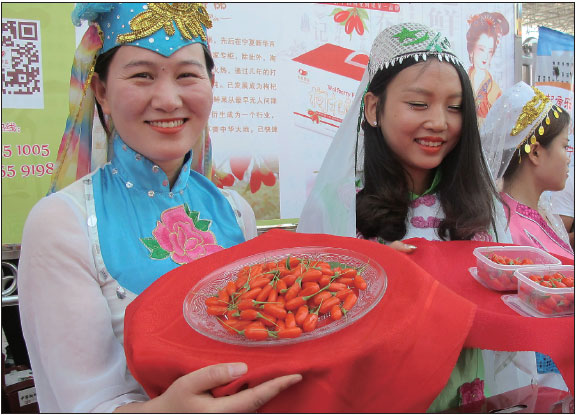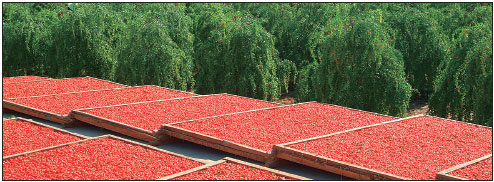Ancient Ningxia agriculture today modernizing, thriving
The increasingly industrialized processing of berries is raising local residents' income
Piles of fresh wolfberries were put onto the production lines, their waxy layer skin peeled off by baking soda, then placed on a bamboo platform and pushed into a drying room for about 30 hours at 40-60 C.
These are the first steps for fresh wolfberries to be dried and turned into the small, wrinkled, red things in Chinese wines or porridge, according to Qian Cuidi, deputy head of the quality control department of Ningxia Qitai Agricultural Technology Co Ltd, a private company founded in 2014 that focuses on the processing of wolfberries in Zhongning, a county in Zhongwei, Northwest China's Ningxia Hui autonomous region.

"We have more than 40 drying workshops," Qian said. "During harvest time, roughly 10 tons of fresh fruit will get produced per day."
According to Qian, the next step is to cut their stalks and classify them into different levels according to their color and shape by machine.
Workers then pick out the fruits with black spots or cracks in the sorting room, remove dust, hairs or iron wires by machine, sterilize them under ultraviolet light and finally get them automatically packed with a QR code printed on the outer package.
Qian said, the human cost is high, as the company pays about 150 yuan ($22.2) to each worker every day for sorting through the wolfberries. During peak season, the total number of workers could reach 500.
"Some processes can only be handled by men," said Qian. "For example, the machine can't detect small defects on the wolfberries. In the summer, the amount of wolfberries we process is very large, which means a lot of workers are needed."
Known as Wolfberry Town in China, Zhongning is a county with an area of 4,226.5 square kilometers and a population of 341,500, of which 59.1 percent belong to the agricultural population.
The county has been promoting the development of the wolfberry industry to increase the income of local residents and boost the local economy.
According to Zhang Xiuping, deputy director of the general office of the Zhongning Wolfberry Industrial Development and Service Bureau, the county now has wolfberry fields covering an area of 13,333.3 hectares with a gross production of 48,000 tons this year.
From January to September, about 3,300 tons of wolfberry were exported to more than 40 countries and regions including the United States, Italy, Brazil and Russia with an annual sales value of over $26.4 million.
Chen Meiling contributed to the story.
zhuanti@chinadaily.com.cn
|
People of the Hui ethnic group in Zhongning showcase wolfberries planted in the county, touted as China's Wolfberry Town.Photos Provided To China Daily |
|
Wolfberries in the drying process, after which the red fruit will undergo further processing before hitting the market. |
(China Daily 11/04/2016 page10)
















